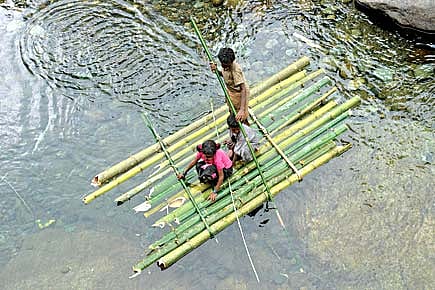The Cave Dwellers of Kerala

The world discovered this endangered tribe in 1970. And then the tribals discovered alcohol
The world discovered this endangered tribe in 1970. And then the tribals discovered alcohol
Getting to the Cholanaikkans, the only remaining tribal community in Asia that lives in rock-cave shelters, is not easy. A highly endangered tribe, they live deep inside the evergreen deciduous jungles of Nilambur, in Kerala's Malappuram district. Trekking through the slippery forest tracks on the banks of river Karimpuzha and braving wild elephants and leeches is risky, but you have no other option if you want to meet the members of the only surviving huntergatherer community in the country.
At Karulai, the entrance to the dark thickets of the jungle, forest department officials expressed doubt about the need for such an unsafe trip, that too with the sole aim of meeting the Cholanaikkans. "Wait at our office for a few hours. Some of them will come here around noon to sell minor forest produces to the local collection centre. Why are you so adamant about meeting them in their original forest settlement?" asked one official. Another official was more practical. "Why waste time here? Go to the tribal museum in Kozhikode. You'll get enough literature on them, apart from seeing their photos with rock-cave shelters in the background,'' he advised.
2026 New Year Issue
Essays by Shashi Tharoor, Sumana Roy, Ram Madhav, Swapan Dasgupta, Carlo Pizzati, Manjari Chaturvedi, TCA Raghavan, Vinita Dawra Nangia, Rami Niranjan Desai, Shylashri Shankar, Roderick Matthews, Suvir Saran
The visit to at least one cave settlement was eventually made possible with the intervention of a local tribal welfare officer. The officer generously volunteered his help as translator, and in deciphering the complex words and phrases of the primitive tribal language.
The total population of the Cholanaikkans is just 363, 161 of them women. They live in 11 cave settlements and have refused the state government's lures of houses with tiled roofs and cultivable land outside the forests. "Traditionally, we are hunters. The severe forest laws are preventing us from hunting and so, our lifestyle has changed altogether,'' says Ravi, the inhabitant of the first rock-cave we sighted, at Karimpuzha. He lives with his wife, mother and four children. In a neighbouring cave live Mathan and his wife Karikka. These caves look clean, and intriguingly, in one of them was a photograph of Malayalam superstar Mammooty.
"Ours is a small settlement with only two families. There are cave settlements far interior, where up to seven families live together,'' says Mathan. He discourages us from venturing any further, saying urban types cannot withstand the challenge of climbing the slippery rocks.
The tribe is largely in a pre-agricultural stage of development. They collect roots, nuts, fruits, honey, ginger, wild pepper and soap seeds and sell them at government-controlled collection centres. The women also make bamboo baskets, which fetch them good money.
The tribe was discovered in 1970. And as contact between the tribals and the outside world increased, many of them became alcoholics.
